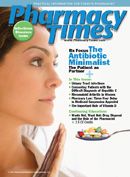Medication Safety: Help Prevent Medication Errors in Schools
Pharmacists can assist school systems in developing and implementing procedures for medication administration and storage.
Dr. Gaunt is a medication safety analyst and the editor of ISMP Medication Safety Alert! Community/Ambulatory Care Edition.
In any given week, 56% of children younger than 18 years of age take at least 1 medication, and 27% take 2 or more; 21% use at least 1 prescription drug.1 Safe and correct medication administration during school hours is a challenge for school systems. American school systems deliver medication to more patients than large hospital or nursing home systems. Approximately 6% of school-aged children (nearly 13 million) receive medications while in school, and 80% of school-related medication errors reported were missed doses.2
Just as with adults, proper medication management improves outcomes for chronic conditions in children. Disease progression, complacency, and bad habits are reinforced when medications are not administered as ordered during school hours. Due to budget cuts, many school systems do not have a dedicated nurse onsite. This leaves school staff, who, in most cases, are untrained for medication delivery, responsible for medication management during the school day. A study by the University of Iowa surveyed 649 school nurses throughout the United States and found that 5.6% of students receive a medication at school each day–75% of which are administered by nonnursing school staff (eg, secretaries, health aides, teachers, and other nonclinical staff).3
The types of medication errors commonly reported in schools include missed doses, incorrect doses, giving a medication without authorization, giving the wrong medication, and other unspecified mistakes.4 What can pharmacists do to help prevent these medication errors?
It is important for each school to have a local pharmacy that they can call if they have questions on medications. Pharmacists can help school systems develop policies and implement practices that will:
- Provide in-service education, including information on the proper storage of medications during school hours and while on field trips.
- Facilitate the training of students and caregivers on proper storage, administration, and waste of medications. Present a program, such as FDA’s Medicines in My Home (www.fda.gov/medsinmyhome), for parents and/or students at a school function.
- Demonstrate the proper use of medical devices and measuring devices to students and caregivers.
- Teach school staff about the differences between prescription medications and nonprescription products, including herbals, dietary supplements, and homeopathic medicines. Explain why it is important to know the active ingredients of prescription and nonprescription products to avoid duplication and potential drug—drug interactions.
- Advise school staff to only accept a prescription medication that is properly labeled; a properly labeled medication must include the patient’s full name, name of the drug, dosage, route of administration, and time interval of the dose along with the prescriber’s name and pharmacy contact information in case of questions.
- Encourage school staff and parents to keep the medication in its original, properly labeled container, so that doses, frequencies, and instructions for accurate administration are always available.
- Show school staff where to locate and how to access current, reliable medication safety and drug information.
- Teach parents to share initial and updated information about their child’s medications with the child and school.
- Remind children that they should never take a medicine unless an authorized adult gives it to them. â–
References
1) Kaufman DW, Kelly JP, Rosenberg L, et al. Patterns of medication use in the United States 2006: A report from the Slone Survey. Boston, MA: Sloane Epidemiology Center, 2008. Available on Internet at: www.bu.edu/slone/SloneSurvey/SloneSurvey.htm. Last viewed on December 15, 2009.
Â
2) Johnson PE, Hayes JM. Medication use in schools. Am J Health Syst Pharm. 2006;63:1277-1285.
Â
3) McCarthy AM, Kelly MW, Reed D. Medication Administration Practices of School Nurses. J Sch Health. 2000;70:371-376.
Â
4) Johnson PE, Hayes JM, Reinstein VF, Simmons SM, Benson J eds. Medication use in schools: Florida edition 2003. Tallahassee, FL: Florida Society of Health-System Pharmacists, 2003.
Subscribe to Newsletter
Pharmacy Times and the Institute for Safe Medication Practices (ISMP) would like to make community pharmacy practitioners aware of a publication that is available. The ISMP Medication Safety Alert! Community/ Ambulatory Care Edition is a monthly compilation of medicationrelated incidents, error-prevention rec- ommendations, news, and editorial content designed to inform and alert community pharmacy practitioners to potentially hazardous situations that may affect patient safety. Individual subscription prices are $52 per year for 12 monthly issues. Discounts are available for organizations with multiple pharmacy sites. This newsletter is delivered electronically. For more information, send an e'mail message to community@ismp.org, or contact ISMP at 215-947-7797.

